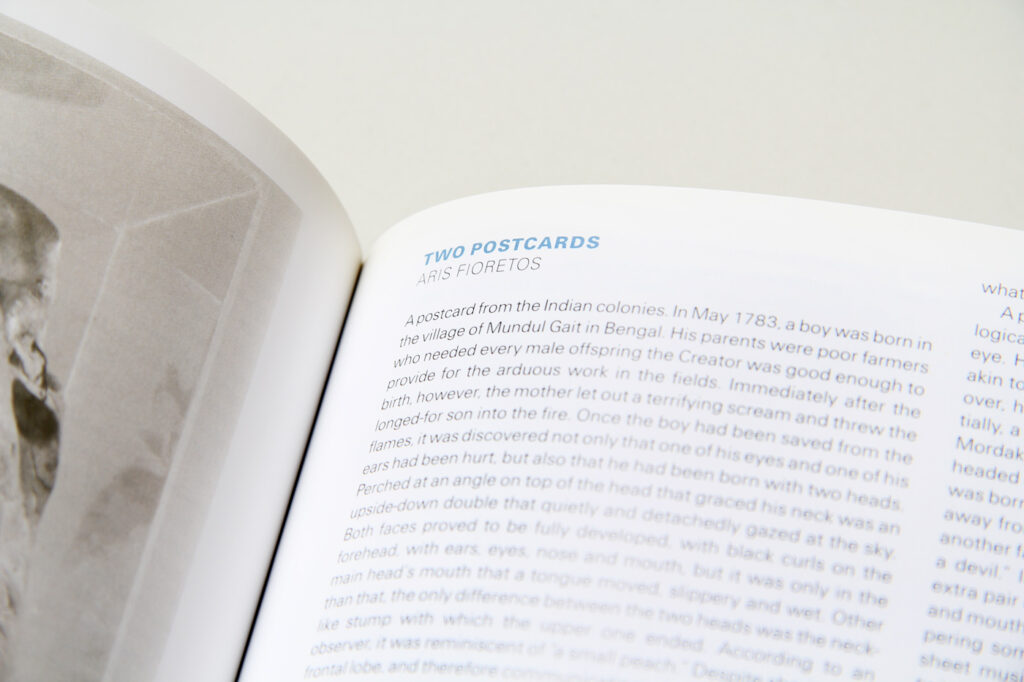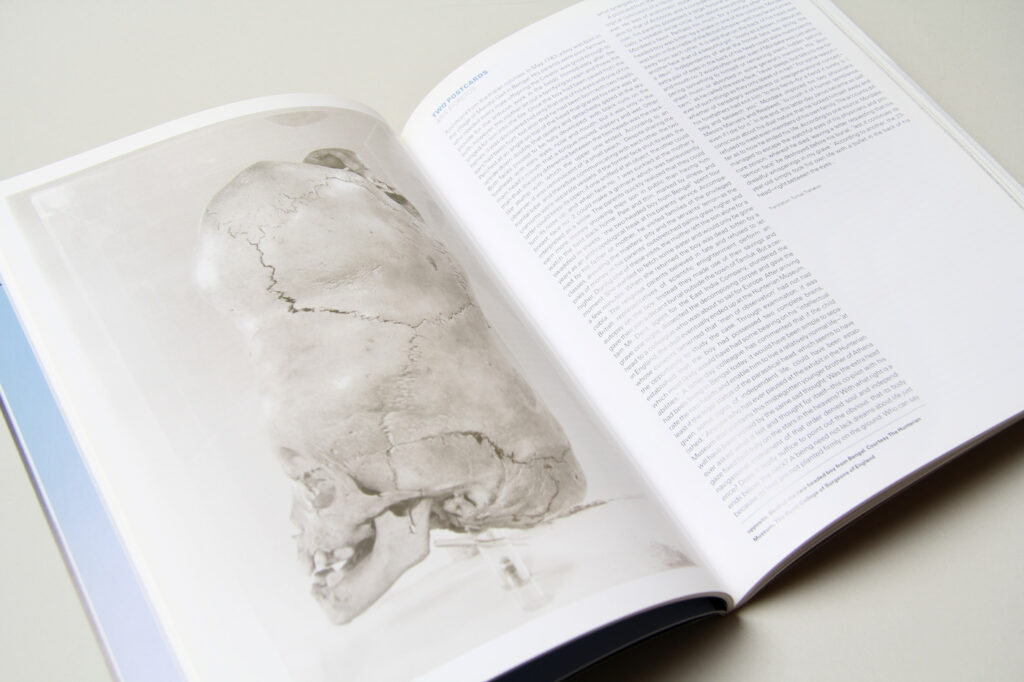


Two Postcards
Short prose · Original title: »Två vykort« · Translation by Tomas Tranæus · From Swedish · Cabinet · 2001, No. 5, pages 92–93 · Photo: Two-Headed Boy from Bengal, The Hunterian Museum
A postcard from the Indian colonies. In May 1783, a boy was born in the village of Mundul Gait in Bengal. His parents were poor farmers who needed every male offspring the Creator was good enough to provide for the arduous work in the fields. Immediately after the birth, however, the mother let out a terrifying scream and threw the longed-for son into the fire. Once the boy had been saved from the flames, it was discovered not only that one of his eyes and one of his ears had been hurt, but also that he had been born with two heads. Perched at an angle on top of the head that graced his neck was an upside-down double that quietly and detachedly gazed at the sky. Both faces proved to be fully developed, with black curls on the forehead, with ears, eyes, nose and mouth, but it was only in the main head’s mouth that a tongue moved, slippery and wet. Other than that, the only difference between the two heads was the necklike stump with which the upper one ended. According to an observer, it was reminiscent of »a small peach.« Despite sharing the frontal lobe, and therefore communicating with each other, the two craniums were separate vessels. If the former face shut its eyes, the latter could keep its open; if one sniffed at an object, the other could turn its nose up; and when face no. 1 was suckled at the mother’s breast, face no. 2 could make a grimace which was benevolently interpreted as a smile. The parents quickly realised that they could earn more money showing their son in public than having him watch the field back home. Pale and thin, marked by illness, and swaddled in sheets, »the two-headed boy from Bengal« spent four years as an anthropological freak at his parents’ service. Accompanied by his father or mother, he visited society families, arousing the masters’ pity and the servants’ terror — as the piles of money in his parents’ outstretched palms grew higher and higher. During one of these visits, the mother left the son alone for a moment. She wanted to fetch some water and would only be gone a few minutes. When she returned the boy was dead, bitten by a cobra. The religious parents believed in fate and refused to let British representatives of scientific enlightenment perform an autopsy on the boy. Instead they made use of their savings and gave their son a decent burial outside the town of Tamluk. But a certain Mr Dent, agent for the East India Company, plundered the grave one night, dissected the decomposing corpse and gave the head to a colleague who was about to sail for Europe. After arriving in England, the skull eventually ended up at the Hunterian Museum, whose curators lamented that »men of observation« had not had the opportunity to study the case. Through examination, it was established that the boy had possessed two complete brains, which most likely would have had some bearing on his »intellectual abilities.« A latter-day colleague has commented that if the child had been living in Bengal today, it would have been simple to separate the two heads and enable him to live a relatively normal life — »at least if the legal status of the parasitical head could have been established. It seems to have shown certain signs of independent life.« Anyone who has ever paused at the exhibit in the Hunterian Museum that contains this misbegotten younger brother of Athena will have been visited by the sad thought: was the extra head ever asked what it felt and thought for itself — this co-pilot with his gaze fixed faithfully on the stars in the heavens? With what right is a navigational instrument of that order denied soul and independence? Does it really suffice to point out the obvious: that its body ends below the neck? A being need not lack dreams about life just because its feet are nor planted firmly on the ground. Who can say what synergies two communicating craniums are capable of?
A postcard from the Empire. Perhaps Edward Mordake drew the logical conclusion of a life one can never look clearly enough in the eye. He was of aristocratic stock, had a handsome appearance, akin to that of Antinous, and a considerable musical talent. Moreover, his parents possessed a large fortune and had, at least initially, a sizeable social circle. Just about everything was in young Mordake’s favour. Perhaps too much, for a century after the two-headed boy was bitten by a snake in one of the colonies, Mordake was born in the cradle of the British Empire — with two faces turned away from each other. It is said that upon the back of his head was another face, that of a beautiful girl, »lovely as a dream, hideous as a devil.« The extra pair of eyes in the back of his head could stare malevolently independently of what the frontal face was doing, and that mouth number two would often sneer even if Mordake was just whispering something to himself or remaining silent, hidden behind sheet music or absorbed in some general’s memoirs. His »devil twin,« as he called this extra face of which images have not survived, »never sleeps, but talks to me forever of such things as they only speak of in hell.« For some reason, hereditary wickedness or intergenerational conceit, his forefathers had knit him »to this fiend — for a fiend it surely is. I beg and beseeach you,« Mordake prevailed on Mssrs Manvers and Readwell, his two physicians, »to crush it of human semblance, even if I die for it.« In the end, this latter-day Janus became so self-conscious about his dual nature that he locked himself away and refused to meet even members of his own family. The accounts differ about how he ended his life. According to one source, Mordake managed to procure poision, in spite of his physicians’ careful watching, whereof he died, leaving a letter requesting that his »demon face« be destroyed before his burial, »lest it continues its dreadful whisperings in my grave.« According to another, the twenty-three year old simply took his own life with a bullet in the back of his head — right between the eyes.